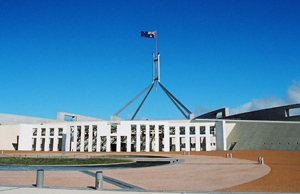
DAVID ADAMS looks at the role of the Speaker in the Australian Parliament…
There’s been a lot of talk about the Speaker of the House of Representatives recently, with the resignation of Bronwyn Bishop and subsequent election of Tony Smith, so we thought we’d take a closer look at the office, its role and its history…

Parliament House in Canberra. PICTURE: David Adams
• The Speaker is the presiding officer of the House of Representatives, meaning it is their role to oversee the running of the house, including determining which of the members may speak, and for maintaining order during debates. The Speaker does not vote except to act as a tiebreaker.
• The Speaker has at their disposal a range of sanctions they can use to maintain order during debates. These include warning a member, ordering them to leave the house for one hour or ‘naming’ them and moving a motion for a member’s suspension (usually for 24 hours).
• The position is modeled on that of the UK’s House of Commons (a position currently held by John Bercow), but unlike the UK where the Speaker abandons all party loyalties on their election, the Speaker in Australia can remain an active member of their party (a matter which has led to some criticism in recent times).
• The office of the Speaker in the UK goes back to the earliest Parliaments. The first identified presiding officer was Peter de Montfort in the Oxford Parliament of 1258 and the first recorded use of the term Speaker dates from 1377.
• The title ‘Speaker’ refers to the original role of the office – which was to “speak” for parliament, that is, report its decisions to the king. In Australia, they still maintain that role of “speaking” for the House of Representatives to other parts of Parliament such as the Senate and the Sovereign (represented by the Governor-General) and other arms of government, including the executive and the judiciary. In early years in the UK, the Speaker was referred to by the various names of ‘Parlour’ (mouth), ‘Prolocutor’ (chairman) and ‘Procurator’ (agent).
• The office was naturally a somewhat dangerous task given the monarch didn’t always want to hear what Parliament had to say and there are instances of early Speakers being beheaded as well as murdered, imprisoned, impeached and expelled from the office. It’s this difficult part of the task which has apparently led to the tradition of the Speaker resisting the office and being “dragged” to the Speaker’s chair when elected (although the danger now is somewhat less than it once was).
• Always nominated by the governing party, the Speaker is elected in a secret ballot conducted by the clerk of the Australian House of Representatives. It is usually conducted immediately following a Federal Election or, as was the case recently, when the Speaker resigns.
• The first female speaker was Labor’s Joan Child (1986-89). Bronwyn Bishop was the third female to hold the office. Other Speakers of note include Harry Jenkins, who served in the office between 2008 and 2011, whose father was also Speaker and Charles McDonald and Sir Elliot Johnson, both of whom served in the role twice in the early 20th century.
• Other nations to feature the office of Speaker in their political systems – aside from the UK – include many of the (now independent) nations of the former Commonwealth and the US where the Speaker presides over the House of Representatives in Congress.
Sources: ‘The Speaker’, Parliament of Australia; Infosheet 3 – The Speaker; ‘Speaker of the Australian House of Representatives.





